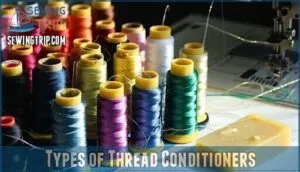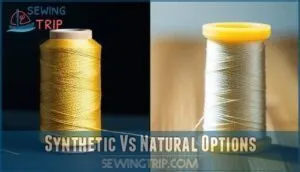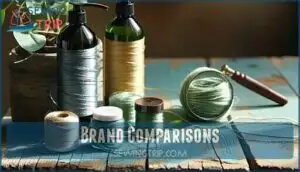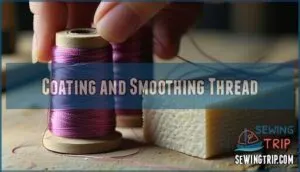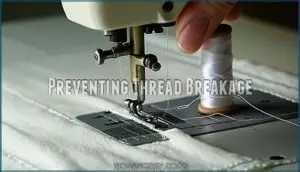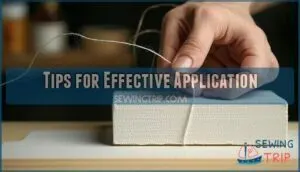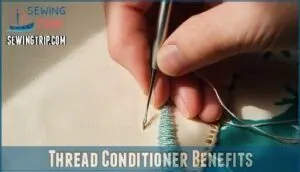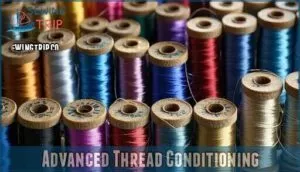This site is supported by our readers. We may earn a commission, at no cost to you, if you purchase through links.
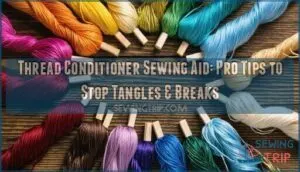 Thread conditioner sewing aid is your secret weapon against sewing frustrations.
Thread conditioner sewing aid is your secret weapon against sewing frustrations.
This waxy or liquid coating smooths thread fibers, eliminating static that causes tangles and knots.
Simply run your thread through the conditioner before threading your needle – it’s like giving your thread a spa day.
The conditioner reduces friction as thread passes through fabric, preventing those annoying breaks mid-stitch.
It works on cotton, silk, metallic, and synthetic threads, making hand embroidery and quilting infinitely smoother.
Think of it as hair conditioner for your threads – it keeps everything sleek and manageable.
Beyond tangle prevention, it actually protects threads from moisture and UV damage.
Once you discover the right application techniques and understand which type works best for your projects, you’ll wonder how you ever sewed without it.
Table Of Contents
Key Takeaways
- You’ll eliminate thread tangles and knots by coating your thread with conditioner before stitching, which smooths fibers and reduces static electricity that causes frustrating snarls.
- Your thread won’t break mid-project because conditioner strengthens fibers by up to 70% and creates a protective barrier that distributes tension evenly through the fabric.
- You can use it on any thread type – cotton, silk, metallic, or synthetic threads all benefit from conditioning, though you should skip textured threads that lose their character.
- Choose between beeswax or synthetic options based on your needs: beeswax provides traditional strength but attracts dirt, while synthetic conditioners like Thread Magic offer a cleaner application without sticky residue.
Thread Conditioner Basics
Thread conditioner transforms your hand sewing from a frustrating tangle fest into smooth, effortless stitching.
Transform stubborn thread into your perfectly obedient stitching companion with this simple conditioning magic.
You’ll wonder how you ever managed without this simple wax or synthetic coating that keeps your thread behaving like a well-trained pet instead of a wild yarn tornado, with effortless stitching being the result.
Purpose and Function
Thread conditioner frequently transforms your hand sewing experience by creating a protective barrier around each fiber.
This thread treatment reduces friction while improving thread care through better fiber alignment.
Here’s what thread conditioner does for you:
- Thread Protection – Guards against fraying and breakage during stitching
- Friction Reduction – Helps your sewing thread glide smoothly through fabric
- Static Control – Eliminates annoying tangles that slow down your work
- Sewing Ease – Makes every stitch feel effortless and professional
Types of Threads Supported
You’ll find that thread conditioner works beautifully with natural threads like cotton and linen, where it truly shines.
Synthetic threads benefit too, though they’re naturally smoother.
Metallic threads become manageable instead of nightmare-inducing tangles.
Delicate threads gain strength and protection from this handy sewing aid.
It also helps in reducing friction and tangling.
However, skip textured threads – they don’t play well with thread treatment and lose their special character.
Benefits for Hand Sewing
Your hands will thank you for using thread conditioner during long sewing sessions.
This magical lubricant transforms stubborn threads into cooperative partners, delivering friction reduction that prevents thread fraying and eliminates those pesky thread tangles.
You’ll experience fatigue reduction as conditioned threads glide effortlessly through fabric, while tangle reduction and enhanced thread strength create stitch durability that lasts.
Common Applications
You’ll find thread conditioner most valuable when tackling quilt binding, where smooth stitches matter.
Appliqué techniques benefit from reduced drag, while embroidery projects shine with tangle-free floss.
Beading applications require strong, conditioned thread that won’t snap mid-project.
Bookbinding uses thread lubricant for durable seams.
Your sewing thread conditioner becomes essential for any hand-stitching where precision counts—think of it as your thread smoother sidekick.
Choosing Thread Conditioner
With so many thread conditioner options available, you’ll want to pick the right one for your specific sewing needs and preferences.
The choice between natural beeswax formulas and synthetic alternatives can make a real difference in how smoothly your hand sewing projects flow.
Types of Thread Conditioners
You’ll discover two main categories when choosing your sewing thread conditioner: natural beeswax formulas and synthetic alternatives.
Each type offers unique application differences and performance benefits for your hand-sewing projects.
- Beeswax benefits: Creates slightly sticky coating that holds thread fibers together, strengthens natural threads like cotton and linen, and provides traditional conditioning that’s been trusted for centuries
- Synthetic alternatives: Offer slick, smooth surface without residue, reduce friction by 400-700% compared to wax, and won’t melt during ironing or attract dirt like beeswax can
- Scented options: Available in creative blends from brands like Sew Fine Thread Gloss with cereal-inspired fragrances, or The Small Circle’s essential oil combinations for aromatherapy while stitching
- Brand comparison: Thread Magic provides archival-friendly synthetic conditioning, while Dritz offers affordable pure beeswax, and Ponderosa features 14 unique scent blends for personalized sewing experiences.
Many vendors offer beeswax-related products for thread care.
Materials and Fragrances
Beeswax sourcing matters when choosing your thread conditioner.
Quality beeswax creates smooth, long-lasting protection, while synthetic alternatives offer consistent performance without allergen concerns.
A great option is beeswax thread conditioner.
Fragrance oils add personality—coconut oil blends provide tropical scents, essential oils offer aromatherapy benefits.
Consider scent longevity; some fragrances fade quickly during stitching.
If you’re sensitive to fragrances, stick with unscented options to avoid reactions.
Synthetic Vs Natural Options
Natural wax thread conditioner offers traditional beeswax benefits but attracts dirt, while synthetic formulas provide cleaner application with less residue comparison issues.
Cost analysis shows synthetics last longer despite higher upfront prices.
Environmental impact favors natural options, though synthetic thread conditioners won’t melt during ironing. Considering the environmental impact of materials is essential for eco-conscious crafters.
Scent preferences vary—beeswax smells earthy, synthetics stay neutral. Durability differences matter for long-term projects.
Brand Comparisons
Thread Magic leads the pack as your go-to thread conditioner, offering superior tangle prevention without sticky residue.
Ponderosa Thread Gloss brings 14 creative scents to your sewing basket, while The Small Circle Thread Wax provides eco-friendly options.
Cost Analysis reveals Thread Magic’s synthetic formula lasts longer than beeswax alternatives, considering Scent Preferences and Application Differences to help determine your perfect match.
For hand stitching, consider beeswax thread conditioners for a robust coating.
Applying Thread Conditioner
Now that you’ve chosen your thread conditioner, it’s time to learn the proper application technique for best results.
You’ll master the simple coating process and discover how to eliminate static while preventing those frustrating thread breaks that can derail your project, using the right technique for best results.
Coating and Smoothing Thread
Three simple steps transform stubborn thread into silk-smooth perfection.
Hold your thread against the conditioner with your thumb, then pull it across the surface using gentle application pressure.
Two passes create the ideal coating thickness without conditioner residue buildup.
Run your fingers along the thread afterward—this smoothing technique removes excess thread lubricant while ensuring proper thread coating.
Your thread will glide effortlessly, preventing thread tangling before it starts.
Removing Static Electricity
When static electricity turns your thread into a clingy nightmare, thread conditioner becomes your antistatic superhero.
Here’s how to zap static buildup:
- Pull synthetic threads through conditioner using steady pressure
- Increase humidity with a small humidifier near your workspace
- Apply anti-static sprays lightly to fabric before stitching
- Try grounding techniques like touching metal before handling thread
Thread conditioner creates a protective barrier that neutralizes static electricity, preventing thread breakage reduction while keeping fibers smooth and manageable.
Preventing Thread Breakage
Well-conditioned threads won’t snap under pressure, saving you from the frustration of re-threading mid-project.
Apply thread conditioner before starting to strengthen fibers and reduce breakage by up to 70%. The protective coating distributes tension evenly, preventing weak spots that cause snaps.
A key advantage is reducing friction and tangling, which helps maintain smooth stitching.
| Factor | Without Conditioner | With Conditioner |
|---|---|---|
| Thread Quality | Weak, prone to fraying | Strong, cohesive fibers |
| Tension Control | Uneven stress points | Smooth, even distribution |
| Needle Size | More friction damage | Reduced wear from passage |
| Knot Prevention | Frequent tangles/breaks | Fewer interruptions needed |
Thread conditioner benefits include enhanced thread strength and thread breakage reduction.
Proper stitch length combined with quality thread conditioner creates durable seams that withstand handling.
Tips for Effective Application
Perfect thread application requires finesse, not force. You’ll master these fundamentals quickly with consistent practice.
Start with light pressure control and gradually adjust coating amount based on your specific thread type.
Key application techniques:
- Hold conditioner firmly while drawing thread across surface with steady motion
- Apply 2-3 gentle passes maximum to avoid residue buildup
- Use smoothing technique by running fingers along thread length after coating
- Clean excess residue immediately to prevent sticky mess
Remember: less is more with thread conditioning, and it’s crucial to maintain a steady motion and avoid residue buildup to achieve the best results.
Thread Conditioner Benefits
You’ll discover that thread conditioner transforms your hand sewing experience by eliminating the frustrations that make you want to throw your project across the room.
Once you start using it regularly, you’ll wonder how you ever managed without this simple tool that turns wrestling with stubborn thread into smooth, effortless stitching.
Reduced Fraying and Tangling
Thread conditioner creates fiber cohesion that dramatically improves thread lifespan and prevents annoying tangles.
When you coat your thread, it forms an antifray barrier that keeps individual fibers together like a protective shield.
This material compatibility means fewer mid-project interruptions from knots or breaks.
Your thread glides smoothly through fabric, reducing the friction that causes fraying and thread tangling prevention becomes automatic for better stitch durability.
Increased Thread Strength
Reinforcing each thread’s fiber composition, conditioner binds fibers together like invisible glue.
This protective coating dramatically improves tensile strength and abrasion resistance while boosting your thread’s load capacity against everyday wear.
Proper storage helps to avoid thread damage overall.
- Enhanced knot strength – Thread conditioner creates stronger, more reliable knots that won’t slip during stitching
- Improved thread durability – Acts as a thread strengthener, extending your thread’s lifespan by reducing fiber breakdown
- Better thread protection – Forms a barrier against environmental damage that weakens fibers over time
- Reduced thread breakage – Strengthened fibers handle tension better, preventing those frustrating mid-stitch snaps
Improved Stitch Quality
Consistently achieving uniform stitches becomes remarkably easier when you use thread conditioner.
Your thread glides smoothly through fabric, maintaining perfect thread tension throughout every stitch.
| Without Conditioner | With Conditioner |
|---|---|
| Uneven tension | Tension consistency |
| Puckered fabric | Reduced puckering |
| Amateur appearance | Professional finish |
| Frequent adjustments | Enhanced durability |
Thread lubrication eliminates the jerky motion that creates irregular stitches, giving you that coveted professional finish every time.
Protection Against Damage
Beyond stitch quality, thread conditioner creates an invisible shield that protects your work from environmental damage.
The protective coating offers UV protection against sun fading, plus moisture barrier properties that prevent mold and mildew growth.
You’ll notice improved soil resistance too—dirt won’t stick as easily to treated threads, which means your finished projects stay vibrant longer, making thread conditioner worth every penny due to the fiber integrity boost.
Advanced Thread Conditioning
Once you’ve mastered basic thread conditioning, you’re ready to tackle specialty threads and challenging projects that demand extra finesse.
These advanced techniques will help you work with metallic threads, handle complex embroidery projects, and understand why synthetic conditioners often outperform traditional beeswax for demanding applications.
Specialized Threads and Projects
Challenging threads require special attention when you’re working with delicate materials.
Metallic thread benefits tremendously from thread conditioner, preventing snags and breakage during intricate work. Thread wax protects these specialty fibers while maintaining their unique properties.
- Metallic thread: Apply thread glaze lightly to prevent tarnishing and reduce friction
- Satin thread: Use minimal thread conditioner to maintain sheen without buildup
- Beading projects: Thread wax strengthens quilting thread for repeated needle pulls
- Bookbinding threads: Condition neon threads to prevent color bleeding and fraying
Historical Context and Evolution
Your sewing ancestors knew something you’re rediscovering today.
Early thread treatments using beeswax origins date back thousands of years, when crafters discovered this golden treasure strengthened fibers beautifully.
Traditional methods evolved through sewing history as industrial lubrication entered factories in the 1800s.
Synthetic development revolutionized everything by the 20th century, replacing sticky thread wax with modern innovations that glide smoothly through fabric without residue.
However, it’s worth noting that beeswax coated threads have been found intact in centuries-old embroidery.
Comparison of Natural and Synthetic Conditioners
Both natural and synthetic thread conditioners offer distinct advantages depending on your sewing needs.
Beeswax provides traditional reliability, while synthetic compounds deliver modern performance benefits.
- Residue Comparison: Beeswax leaves sticky coating that attracts dust; synthetic options create slick surfaces with minimal buildup
- Durability Differences: Natural options require heat-setting and frequent reapplication; synthetic compounds maintain consistency longer
- Application Ease: Synthetic thread conditioner glides smoothly with less mess; beeswax needs warming for ideal coverage
Frequently Asked Questions (FAQs)
What can I use as thread conditioner?
You’ve got several options for thread conditioning.
Beeswax works great—it’s been the go-to for centuries.
Synthetic conditioners like Thread Magic offer smoother results without stickiness.
Commercial products include Sew Fine Thread Gloss and Thread Heaven for different preferences.
What does thread conditioner do?
Thread conditioner strengthens your thread, prevents tangles and fraying, reduces static electricity, and makes hand sewing smoother by decreasing drag through fabric for easier stitching.
Can you use candle wax as thread conditioner?
Need a quick fix for tangled thread? You can use candle wax as thread conditioner, but it’s messier than purpose-made options. Apply sparingly to avoid sticky buildup that attracts dirt.
Can thread conditioner expire or go bad?
Most thread conditioners won’t expire if stored properly, but they can degrade over time.
Beeswax-based ones may harden or collect dust, while synthetic versions stay fresh longer.
Keep yours sealed and clean—it’ll last years without losing effectiveness.
How to store thread conditioner properly?
Like a treasured recipe that stays fresh when stored right, your conditioner needs cool, dry places away from direct sunlight and heat.
Keep containers tightly sealed to prevent dust contamination and maintain consistency for smooth stitching adventures.
Does thread conditioner affect washing or cleaning?
Most thread conditioners won’t cause washing problems since they’re designed to be gentle on fabric.
However, beeswax-based types might attract dirt over time, so you’ll want to wash items normally to remove any buildup.
Can thread conditioner stain light colored fabrics?
Beeswax-based conditioners can leave yellowish residues on white fabrics, while synthetic options like Thread Magic won’t stain. You’ll want to test conditioners on fabric scraps first, especially for whitework projects.
Is thread conditioner safe for childrens clothing?
Absolutely, you can safely use thread conditioner on children’s clothing.
These products are textile-safe and non-toxic, designed specifically for fabric applications.
They won’t harm delicate skin or cause irritation when properly applied to thread before stitching.
Conclusion
Funny how something so simple can solve your biggest sewing headaches.
You’ve probably spent more time untangling threads than actually stitching, yet thread conditioner sewing aid sits quietly in craft stores, waiting to rescue your projects.
This humble helper transforms frustrating sewing sessions into smooth, enjoyable experiences.
Whether you’re working with delicate silk or stubborn metallic threads, the right conditioner makes all the difference.
Don’t let another project suffer from broken threads and tangled messes when the solution costs just a few dollars, and with the help of a sewing aid, you can avoid these issues.
- https://superstitch.com/product/dritz-sewers-aid-thread-conditioner-0-5oz
- https://suzyquilts.com/the-ultimate-guide-to-thread-conditioner
- https://blog.ricoma.com/2024/06/07/embroidery-thread-conditioner
- https://www.quiltingboard.com/main-f1/what-sewers-aid-t65173.html
- https://www.benziedesign.com/blogs/tutorials/guide-to-thread-conditioners

